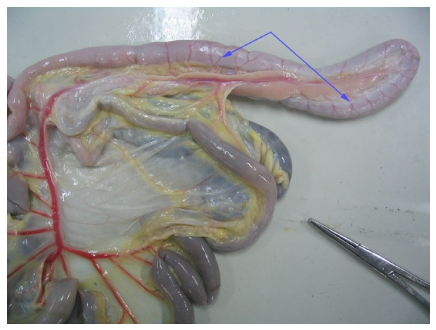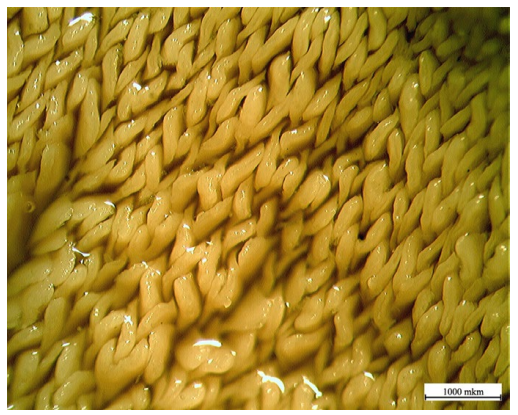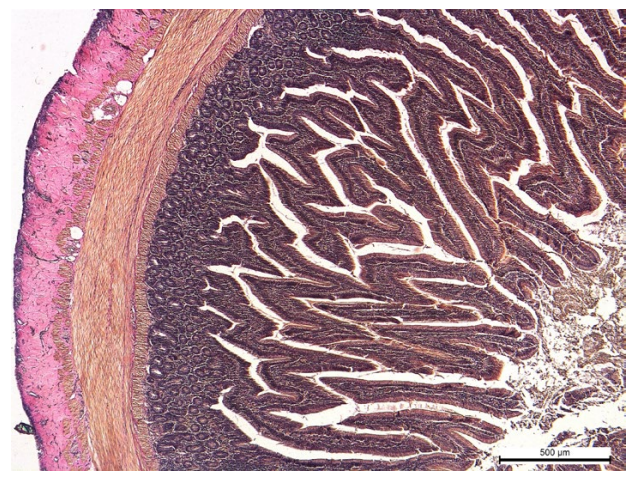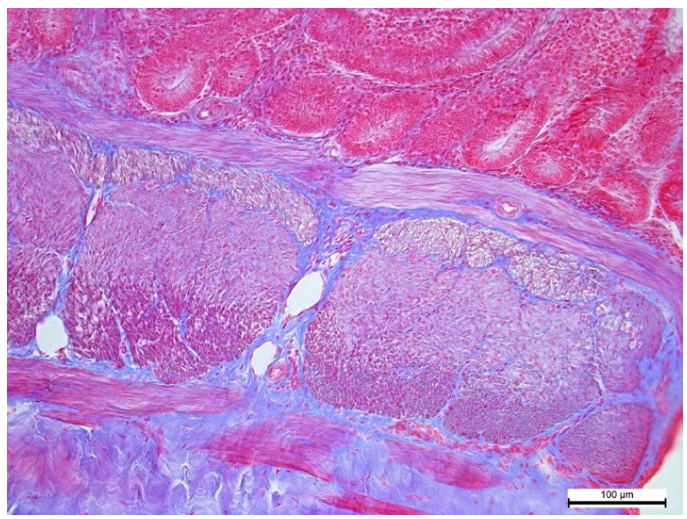1. Hughes RJ. Energy metabolism in chickens: Physiological limitations. Adelaide, SA, Australia: Rural Industries Research and Development Corporation; 2003: 1-62.
2. Karaca T, Yörük M. A morphological and histometrical study on distribution and heterogeneity of mast cells of chicken’s and quail’s digestive tract. YYU Vet Fak Derg. 2004; 15(1-2): 115-121. Web site. http://vfdergi.yyu.edu.tr/archive/2004/15_1-2/2004_15_(1-2)_115-121.pdf. Accessed March 28, 2016
3. Duke GE. Gastrointestinal physiology and nutrition in wild birds. Proc Nutr Soc. 1997; 56(3): 1049-1056. doi: 10.1079/PNS19970109
4. Nasrin M, Siddiqi MNH, Masum MA, Wares MA. Gross and histological studies of digestive tract of broilers during postnatal growth and development. J Bangladesh Agril Univ. 2012; 10(1): 69-77. doi: 10.3329/jbau.v10i1.12096
5. Shih BL, Chen Y-H, Hsu J-C. Morphological development of the small intestine in white Roman goslings. Afr J Biotechnol. 2013; 12(6): 611-617. doi: 10.5897/AJB11.1526
6. Kadhim KK, Bakar MZA, Noordin MM, Babjee MA, Saad MZ. Light and scanning electron microscopy of the small intestine of young malaysian village chicken and commercial broiler. Pertanika J Trop Agric Sci. 2014; 37(1): 51-64.
7. Mott CR, Siegel PB, Webb KE Jr, Wong EA. Gene expression of nutrient transporters in the small intestine of chickens from lines divergently selected for high or low juvenile body weight. Poultry Sci. 2008; 87(11): 2215-2224. doi: 10.3382/ps.2008-00101
8. Mahmud MA, Shaba P, Shehu SA, Danmaigoro A, Gana J, Abdussalam W. Gross morphological and morphometric studies on digestive tracts of three nigerian indigenous genotypes of chicken with special reference to sexual dimorphism. J. World’s Poult Res. 2015; 5(2): 32-41. Web site. http://agris.fao.org/agris-search/search.do?recordID=IR2015400050. Accessed March 28, 2016
9. Oliveira JE, Druyan S, Uni Z, Ashwell CM, Ferket P.R. Prehatch intestinal maturation of turkey embryos demonstrated through gene expression patterns. Poultry Sci. 2009; 88(12): 2600-2609. doi: 10.3382/ps.2008-00548
10. Fisinin VI, Suraj P. Gut immunity in birds: facts and reflections (review). Agricultural Вiology. 2013; 4: 3-25. Web site. http://cyberleninka.ru/article/n/gut-immunity-in-birds-facts-and-reflections-review. Accessed March 28, 2016
11.Horra MCDL, Cano M, Peral MJ, Calonge ML, Ilundain AA. Hormonal regulation of chicken intestinal NHE and SGLT-1 activities. Am J Physiol Regulatory Integrative Comp Physiol. 2001; 280: 655-660. Web site. http://ajpregu.physiology.org/content/280/3/R655.short. Accessed March 28, 2016
12. Muir WI, Bryden WL, Husband AJ. Immunity, vaccination and the avian intestinal tract. Dev Comp Immunol. 2000; 24(2-3): 325-342. doi: 10.1016/S0145-305X(99)00081-6
13. Rawdon B.B. Gastrointestinal hormones in birds: Morphological, chemical, and developmental aspects. J Exp Zool. 1984; 232(3): 659-670. doi: 10.1002/jez.1402320335
14. Vylitova M, Miksik I, Pacha J. Metabolism of corticosterone in mammalian and avian intestine. Gen Comp Endocrinol. 1998; 109(3): 315-324. doi: 10.1006/gcen.1997.7035
15. Stappenbeck TS, Hooper LV, Gordon JI. Developmental regulation of intestinal angiogenesis by indigenous microbes via Paneth cells. PNAS. 2002; 99(24): 15451-15455. doi: 10.1073/pnas.202604299
16. Dibner JJ, Richards JD. The digestive system: Challenges and opportunities. J Appl Poult Res. 2004; 13(1): 86-93. doi: 10.1093/japr/13.1.86
17. Adil S, Banday T, Ahmad Bhat G, Salahuddin M, Raquib M, Shanaz S. Response of broiler chicken to dietary supplementation of organic acids. JCEA. 2011; 12(3): 498-508 doi: 10.5513/JCEA01/12.3.947
18. Incharoen T. Histological adaptations of the gastrointestinal tract of broilers fed diets containing insoluble fiber from rice hull meal. Am J Anim Vet Sci. 2013; 8(2): 79-88. doi: 10.3844/ajavssp.2013.79.88
19. Revajová V, Slaminková Z, Grešáková Ľ, Levkut M. Duodenal morphology and immune responses of broiler chickens fed low doses of deoxynivalenol. Acta Vet Brno. 2013; 82: 337-342. doi: 10.2754/avb201382030337
20. Pelicano ERL, Souza PA, Souza HBA, Figueiredo DF, Amaral CMC. Morphometry and ultra-structure of the intestinal mucosa of broilers fed different additives. Rev Bras Cienc Avic. 2007; 9(3): 173-180. doi: 10.1590/S1516-635X2007000300006
21. Sittiya J, Yamauchi K. Growth performance and histological intestinal alterations of sanuki cochin chickens fed diets diluted with untreated whole-grain paddy rice. J Poult Sci. 2014; 51(1): 52-57. doi: 10.2141/jpsa.0130042
22. Bar-Shira E, Cohen I, Elad O, Friedman A. Role of goblet cells and mucin layer in protecting maternal IgA in precocious birds. Dev Comp Immunol. 2014; 44(1): 186-194. doi: 10.1016/j.dci.2013.12.010
23. Shao Y, Guo Y, Wang Z. β-1,3/1,6-Glucan alleviated intestinal mucosal barrier impairment of broiler chickens challenged with Salmonella enterica serovar Typhimurium. Poult Sci. 2013; 92(7): 1764-1773. doi: 10.3382/ps.2013-03029
24. Zhang, B., Shao Y, Liu D, Yin P, Guo Y, Yuan J. Zinc prevents Salmonella enterica serovar Typhimurium-induced loss of intestinal mucosal barrier function in broiler chickens. Avian Pathol. 2012; 41(4): 361-367. doi: 10.1080/03079457.2012.692155
25. Baevskij RM. Analiz variabel’nosti serdechnogo ritma: istorija i filosofija, teorija i praktika [Analysis of heart rate variability: the history and philosophy, theory and practice]. Klinicheskaja informatika i telemedicina [Clinical informatics and telemedicine]. 2004; 1: 54-64. (Rus.)
26. Baevskij RM, Kirilov OI, Kleckin SZ. Matematicheskij analiz izminenij serdechnogo ritma pri stresse [Mathematical analysis of changes in heart rate during stress]. Moscow. USSR: Nauka, 1984. (Rus.)
27. Hart rate variability. Standarts of measurements, physiological interpretation, and clinical use. Task force of the european of cardiology and the north american society of pacing and electrophysiology. Circulation. 1996; 93: 1043-1065. doi: 10.1161/01.CIR.93.5.1043
28. Mulisch M, Welsch U. Romeis – Mikroskopische Technik. Spektrum akademischer verlag; 2010. doi: 10.1007/978-3-8274-2254-5
29. Yovchev D, Dimitrov D, Penchev G. Age weight and morphometrical parameters of the bronze turkey’s (Meleagris meleagris gallopavo) intestines. Bulg J Agric Sci. 2013; 19(3): 611-614. Web site. http://www.agrojournal.org/19/03-36.pdf. Accessed March 28, 2016
30. Kadhim KK, Zuki ABZ, Noordin MM, Babjee SA, Khamas W. Growth evaluation of selected digestive organs from day one to four months post-hatch in two breeds of chicken known to differ greatly in growth rate. Journal of Animal and Veterinary Advances. 2010; 9(6): 995-1004. doi: 10.3923/javaa.2010.995.1004
31. Yamauchi Review on chicken intestinal villus histological alterations related with intestinal function. J Poult Sci. 2002; 39(4): 229-242. doi: 10.2141/jpsa.39.229
32. Mitjans M, Barniol G, Ferrer R. Mucosal surface area in chicken small intestine during development. Cell Tissue Res. 1997; 290(1): 71-78. doi: 10.1007/s004410050909
33. Pelicano ERL, Souza PA, Souza HBA, et al. Intestinal mucosa development in broiler chickens fed natural growth promoters. Brazilian Journal of Poultry Science. 2005; 7(4): 221-229. doi: 1590/S1516-635X2005000400005
34. Awad W, Ghareeb K, Böhm J. Intestinal structure and function of broiler chickens on diets supplemented with a synbiotic containing enterococcus faecium and oligosaccharides. Int J Mol Sci. 2008; 9(11): 2205-2216. doi: 10.3390/ijms9112205
35. Laudadio V, Passantino L, Perillo A, et al. Productive performance and histological features of intestinal mucosa of broiler chickens fed different dietary protein levels. Poultry Sci. 2012; 91(1): 265-270. doi: 10.3382/ps.2011-01675
36. Wali ON, Kadhim KK. Histomorphological comparison of proventriculus and small intestine of heavy and light line pre- and at hatching. Int J Anim Veter Adv. 2014; 6(1): 40-47. Web site. http://www.airitilibrary.com/Publication/alDetailedMesh?docid=20412908-201402-201507200026-201507200026-40-47. Accessed March 28, 2016
37. Clench MH, Mathias JR. Motility responses to fasting in the gastrointestinal tract of three avian species. The condor. 1995; 97(4): 1041-1047. doi: 10.2307/1369542
38. Hodgkiss JP. Intrinsic reflexes underlying peristalsis in the small intestine of the domestic fowl. J Physiol. 1986; 380(1): 311-328. doi: 10.1113/jphysiol.1986.sp016287









